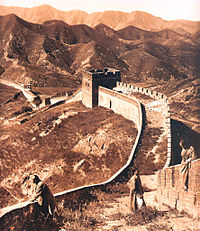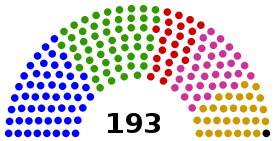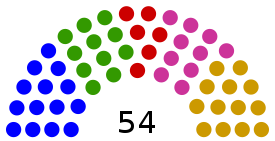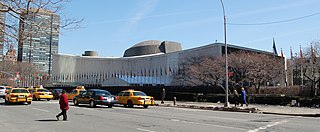From Wikipedia, the free encyclopedia
| Membership and participation
|
|
For two articles dealing with the membership of and participation in the General Assembly, see:
|
The United Nations General Assembly (UNGA or GA; French: Assemblée générale, AG) is one of the six principal organs of the United Nations
(UN), serving as the main deliberative, policy-making, and
representative organ of the UN. Its powers, composition, functions, and
procedures are set out in Chapter IV of the United Nations Charter. The UNGA is responsible for the UN budget, appointing the non-permanent members to the Security Council, appointing the Secretary-General of the United Nations, receiving reports from other parts of the UN system, and making recommendations through resolutions. It also establishes numerous subsidiary organs to advance or assist in its broad mandate. The UNGA is the only UN organ wherein all member states have equal representation.
The General Assembly meets under its president or the UN secretary-general in annual sessions at UN headquarters
in New York City; the main part of these meetings generally run from
September to part of January until all issues are addressed (which is
often before the next session starts). It can also reconvene for special and emergency special sessions. The first session was convened on 10 January 1946 in the Methodist Central Hall in London and included representatives of the 51 founding nations.
Voting in the General Assembly on certain important
questions—namely recommendations on peace and security; budgetary
concerns; and the election, admission, suspension or expulsion of
members—is by a two-thirds majority of those present and voting. Other questions are decided by a simple majority.
Each member country has one vote. Apart from the approval of budgetary
matters, including the adoption of a scale of assessment, Assembly
resolutions are not binding on the members. The Assembly may make
recommendations on any matters within the scope of the UN, except
matters of peace and security under the Security Council consideration.
During the 1980s, the Assembly became a forum for "North-South
dialogue" between industrialized nations and developing countries on a
range of international issues. These issues came to the fore because of
the phenomenal growth and changing makeup of the UN membership. In 1945,
the UN had 51 members, which by the 21st century nearly quadrupled to
193, of which more than two-thirds are developing.
Because of their numbers, developing countries are often able to
determine the agenda of the Assembly (using coordinating groups like the
G77),
the character of its debates, and the nature of its decisions. For many
developing countries, the UN is the source of much of their diplomatic
influence and the principal outlet for their foreign relations
initiatives.
Although the resolutions passed by the General Assembly do not
have the binding forces over the member nations (apart from budgetary
measures), pursuant to its Uniting for Peace
resolution of November 1950 (resolution 377 (V)), the Assembly may also
take action if the Security Council fails to act, owing to the negative
vote of a permanent member,
in a case where there appears to be a threat to the peace, breach of
the peace or act of aggression. The Assembly can consider the matter
immediately with a view to making recommendations to Members for
collective measures to maintain or restore international peace and
security.
History
Methodist Central Hall, London, the location of the first meeting of the United Nations General Assembly in 1946.
The first session of the UN General Assembly was convened on 10 January 1946 in the Methodist Central Hall in London and included representatives of 51 nations. The next few annual sessions were held in different cities: the second session in New York City, and the third in Paris. It moved to the permanent Headquarters of the United Nations in New York City at the start of its seventh regular annual session, on 14 October 1952. In December 1988, in order to hear Yasser Arafat, the General Assembly organized its 29th session in the Palace of Nations, in Geneva, Switzerland.
Membership
All 193 members of the United Nations are members of the General
Assembly, with the addition of Holy See and Palestine as observer
states. Further, the United Nations General Assembly may grant observer status
to an international organization or entity, which entitles the entity
to participate in the work of the United Nations General Assembly,
though with limitations.
Agenda
The
agenda for each session is planned up to seven months in advance and
begins with the release of a preliminary list of items to be included in
the provisional agenda.
This is refined into a provisional agenda 60 days before the opening of
the session. After the session begins, the final agenda is adopted in a
plenary meeting which allocates the work to the various Main
Committees, who later submit reports back to the Assembly for adoption
by consensus or by vote.
Items on the agenda are numbered. Regular plenary sessions of the
General Assembly in recent years have initially been scheduled to be
held over the course of just three months; however, additional workloads
have extended these sessions until just short of the next session. The
routinely scheduled portions of the sessions normally commence on "the
Tuesday of the third week in September, counting from the first week
that contains at least one working day", per the UN Rules of Procedure. The last two of these Regular sessions were routinely scheduled to recess exactly three months afterwards in early December, but were resumed in January and extended until just before the beginning of the following sessions.
Resolutions
Russian President
Dmitry Medvedev addresses the 64th session of the UN General Assembly on 24 September 2009
The General Assembly votes on many resolutions brought forth by
sponsoring states. These are generally statements symbolizing the sense
of the international community about an array of world issues.
Most General Assembly resolutions are not enforceable as a legal or
practical matter, because the General Assembly lacks enforcement powers
with respect to most issues. The General Assembly has authority to make final decisions in some areas such as the United Nations budget.
The General Assembly can also refer an issue to the Security Council to put in place a binding resolution.
Resolution numbering scheme
From
the First to the Thirtieth General Assembly sessions, all General
Assembly resolutions were numbered consecutively, with the resolution
number followed by the session number in Roman numbers (for example, Resolution 1514 (XV),
which was the 1514th numbered resolution adopted by the Assembly, and
was adopted at the Fifteenth Regular Session (1960)). Beginning in the
Thirty-First Session, resolutions are numbered by individual session
(for example Resolution 41/10 represents the 10th resolution adopted at
the Forty-First Session).
Budget
The
General Assembly also approves the budget of the United Nations and
decides how much money each member state must pay to run the
organization.
The Charter of the United Nations gives responsibility for
approving the budget to the General Assembly (Chapter IV, Article 17)
and for preparing the budget to the Secretary-General, as "chief
administrative officer" (Chapter XV, Article 97). The Charter also
addresses the non-payment of assessed contributions (Chapter IV, Article
19).
The planning, programming, budgeting, monitoring and evaluation cycle of
the United Nations has evolved over the years; major resolutions on the
process include General Assembly resolutions: 41/213 of 19 December
1986, 42/211 of 21 December 1987, and 45/248 of 21 December 1990.
The budget covers the costs of United Nations programmes in areas
such as political affairs, international justice and law, international
cooperation for development, public information, human rights, and
humanitarian affairs.
The main source of funds for the regular budget is the
contributions of member states. The scale of assessments is based on the
capacity of countries to pay. This is determined by considering their
relative shares of total gross national product, adjusted to take into
account a number of factors, including their per capita incomes.
In addition to the regular budget, member states are assessed for
the costs of the international tribunals and, in accordance with a
modified version of the basic scale, for the costs of peacekeeping
operations.
Elections
Division of the General Assembly by membership in the five United Nations Regional Groups:
The Group of African States (54)
The Group of Asia-Pacific States (54)
The Group of Eastern European States (23)
The Group of Latin American and Caribbean States (33)
The Group of Western European and Other States (28)
No group
The General Assembly is entrusted in the United Nations Charter with
electing members to various organs within the United Nations system. The
procedure for these elections can be found in Section 15 of the Rules
of Procedure for the General Assembly. The most important elections for
the General Assembly include those for the upcoming President of the General Assembly, the Security Council, the Economic and Social Council, the Human Rights Council and the International Court of Justice. Most elections are held annually, with the exception of the election of judges to the ICJ, which happens triennially.
The Assembly annually elects five non-permanent members of the
Security Council for two-year terms, 18 members of the Economic and
Social Council for three-year terms and 14–18 members of the Human
Rights Council for three-year terms. It also elects the leadership of
the next General Assembly session, i.e. the next President of the
General Assembly, the 21 Vice-Presidents and the bureaux of the six main
committees.
Elections to the International Court of Justice take place every
three years in order to ensure continuity within the court. In these
elections, five judges are elected for nine-year terms. These elections
are held jointly with the Security Council, with candidates needing to
receive an absolute majority of the votes in both bodies.
The Assembly also, in conjunction with the Security Council, selects the next Secretary-General
of the United Nations. The main part of these elections are held in the
Security Council, with the General Assembly simply appointing the
candidate that receives the Council's nomination.
Regional groups
Division of seats of the Economic and Social Council based on regional grouping:
African States (14)
Asia-Pacific States (11)
Eastern European States (6)
Latin American and Caribbean States (10)
Western European and Other States (13)
The United Nations Regional Groups
were created in order to facilitate the equitable geographical
distribution of seats among the Member States in different United
Nations bodies. Resolution 33/138 of the General Assembly states that
"the composition of the various organs of the United Nations should be
so constituted as to ensure their representative character." Thus,
member States of the United Nations are informally divided into five
regions, with most bodies in the United Nations system having a specific
number of seats allocated for each regional group. Additionally, the
leadership of most bodies also rotates between the regional groups, such
as the presidency of the General Assembly and the chairmanship of the
six main committees.
The regional groups work according to the consensus principle.
Candidates who are endorsed by them are, as a rule, elected by the
General Assembly in any subsequent elections.
Sessions
Regular sessions
The
General Assembly meets annually in a regular session that opens on the
third Tuesday of September, and runs until the following September.
Sessions are held at United Nations Headquarters in New York unless
changed by the General Assembly by a majority vote.
The regular session is split into two distinct periods, the main
and resumed parts of the session. During the main part of the session,
which runs from the opening of the session until Christmas break in
December, most of the work of the Assembly is done. This period is the
Assembly's most intense period of work and includes the general debate
and the bulk of the work of the Main Committees. The resumed part of the
session, however, which runs from January until the beginning of the
new session, includes most thematic debates, consultation processes led
by the President of the General Assembly, and working group meetings.
General debate
Brazilian President
Dilma Rousseff
delivers the opening speech at the 66th Session of the General Assembly
on 21 September 2011, marking the first time a woman opened a United
Nations session
The general debate of each new session of the General Assembly is
held the week following the official opening of the session, typically
the following Tuesday, and is held without interruption for nine working
days. The general debate is a high-level event, typically attended by
Member States' Heads of State or Government,
government ministers and United Nations delegates. At the general
debate, Member States are given the opportunity to raise attention to
topics or issues that they feel are important. In addition to the
general debate, there are also many other high-level thematic meetings,
summits and informal events held during general debate week.
The General debate is held in the General Assembly Hall at the United Nations Headquarters in New York.
Special sessions
Special sessions, or UNGASS, may be convened in three different ways,
at the request of the Security Council, at the request of a majority of
United Nations members States or by a single member, as long as a
majority concurs. Special sessions typically cover one single topic and
end with the adoption of one or two outcome documents, such as a
political declaration, action plan or strategy to combat said topic.
They are also typically high-level events with participation from heads
of state and government, as well as by government ministers. There have
been 30 special sessions in the history of the United Nations.
Emergency special sessions
In the event that the Security Council is unable, usually due to
disagreement among the permanent members, to come to a decision on a
threat to international peace and security, the General Assembly may
call an emergency special session in order to make appropriate
recommendations to Members States for collective measures. This power
was given to the Assembly in Resolution 377(V) of 3 November 1950.
Emergency special sessions can be called by the Security Council,
if supported by at least seven members, or by a majority of Member
States of the United Nations. If enough votes are had, the Assembly must
meet within 24 hours, with Members being notified at least twelve hours
before the opening of the session. There have been 10 emergency special
sessions in the history of the United Nations.
Subsidiary organs
The United Nations General Assembly building
The General Assembly subsidiary organs are divided into five
categories: committees (30 total, six main), commissions (six), boards
(seven), councils (four) and panels (one), working groups, and "other".
Committees
Main committees
The main committees are ordinally numbered, 1–6:
The roles of many of the main committees have changed over time.
Until the late 1970s, the First Committee was the Political and Security
Committee (POLISEC) and there was also a sufficient number of
additional "political" matters that an additional, unnumbered main
committee, called the Special Political Committee, also sat. The Fourth
Committee formerly handled Trusteeship and Decolonization matters. With
the decreasing number of such matters to be addressed as the trust territories attained independence and the decolonization movement progressed, the functions of the Special Political Committee were merged into the Fourth Committee during the 1990s.
Each main committee consists of all the members of the General Assembly. Each elects a chairman, three vice chairmen, and a rapporteur at the outset of each regular General Assembly session.
Other committees
These are not numbered. According to the General Assembly website, the most important are:
- Credentials Committee – This committee is charged with ensuring that the diplomatic credentials
of all UN representatives are in order. The Credentials Committee
consists of nine Member States elected early in each regular General
Assembly session.
- General Committee –
This is a supervisory committee entrusted with ensuring that the whole
meeting of the Assembly goes smoothly. The General Committee consists of
the president and vice presidents of the current General Assembly
session and the chairman of each of the six Main Committees.
Other committees of the General Assembly are enumerated.
Commissions
There are six commissions:
Despite its name, the former United Nations Commission on Human Rights (UNCHR) was actually a subsidiary body of ECOSOC.
Boards
There are seven boards which are categorized into two groups:
a) Executive Boards and b) Boards
Executive Boards
- Executive Board of the United Nations Children's Fund, established by GA Resolution 57 (I) and 48/162
- Executive Board of the United Nations Development Programme and of
the United Nations Population Fund, established by GA Resolution 2029
(XX) and 48/162
- Executive Board of the World Food Programme, established by GA Resolution 50/8
Boards
- Board of Auditors, established by GA Resolution 74 (I)
- Trade and Development Board, established by GA Resolution 1995 (XIX)
- United Nations Joint Staff Pension Board, established by GA Resolution 248 (III)
- Advisory Board on Disarmament Matters, established by GA Resolution 37/99 K
Councils and panels
The newest council is the United Nations Human Rights Council, which replaced the aforementioned UNCHR in March 2006.
There are a total of four councils and one panel.
Working Groups and other
There is a varied group of working groups and other subsidiary bodies.
Seating
Countries
are seated alphabetically in the General Assembly according to English
translations of the countries' names. The country which occupies the
front-most left position is determined annually by the Secretary-General
via ballot draw. The remaining countries follow alphabetically after
it.
Reform and UNPA
On 21 March 2005, Secretary-General Kofi Annan presented a report, In Larger Freedom,
that criticized the General Assembly for focusing so much on consensus
that it was passing watered-down resolutions reflecting "the lowest
common denominator of widely different opinions".
He also criticized the Assembly for trying to address too broad an
agenda, instead of focusing on "the major substantive issues of the day,
such as international migration
and the long-debated comprehensive convention on terrorism". Annan
recommended streamlining the General Assembly's agenda, committee
structure, and procedures; strengthening the role and authority of its president; enhancing the role of civil society; and establishing a mechanism to review the decisions of its committees, in order to minimize unfunded mandates and micromanagement of the United Nations Secretariat.
Annan reminded UN members of their responsibility to implement reforms,
if they expect to realize improvements in UN effectiveness.
The reform proposals were not taken up by the United Nations
World Summit in September 2005. Instead, the Summit solely affirmed the
central position of the General Assembly as the chief deliberative,
policymaking and representative organ of the United Nations, as well as
the advisory role of the Assembly in the process of standard-setting and
the codification of international law. The Summit also called for
strengthening the relationship between the General Assembly and the
other principal organs to ensure better coordination on topical issues
that required coordinated action by the United Nations, in accordance
with their respective mandates.
A United Nations Parliamentary Assembly, or United Nations
People's Assembly (UNPA), is a proposed addition to the United Nations
System that eventually could allow for direct election of UN parliament
members by citizens all over the world.
In the General Debate of the 65th General Assembly, Jorge Valero, representing Venezuela,
said "The United Nations has exhausted its model and it is not simply a
matter of proceeding with reform, the twenty-first century demands deep
changes that are only possible with a rebuilding of this organisation."
He pointed to the futility of resolutions concerning the Cuban embargo and the Middle East conflict
as reasons for the UN model having failed. Venezuela also called for
the suspension of veto rights in the Security Council because it was a
"remnant of the Second World War [it] is incompatible with the principle
of sovereign equality of States".
Reform of the United Nations General Assembly includes proposals
to change the powers and composition of the U.N. General Assembly. This
could include, for example, tasking the Assembly with evaluating how
well member states implement UNGA resolutions, increasing the power of the assembly vis-à-vis the United Nations Security Council, or making debates more constructive and less repetitive.
Sidelines of the General Assembly
The
annual session of the United Nations General Assembly is accompanied by
independent meetings between world leaders, better known as meetings
taking place on the sidelines of the Assembly meeting. The
diplomatic congregation has also since evolved into a week attracting
wealthy and influential individuals from around the world to New York
City to address various agendas, ranging from humanitarian and
environmental to business and political.




















